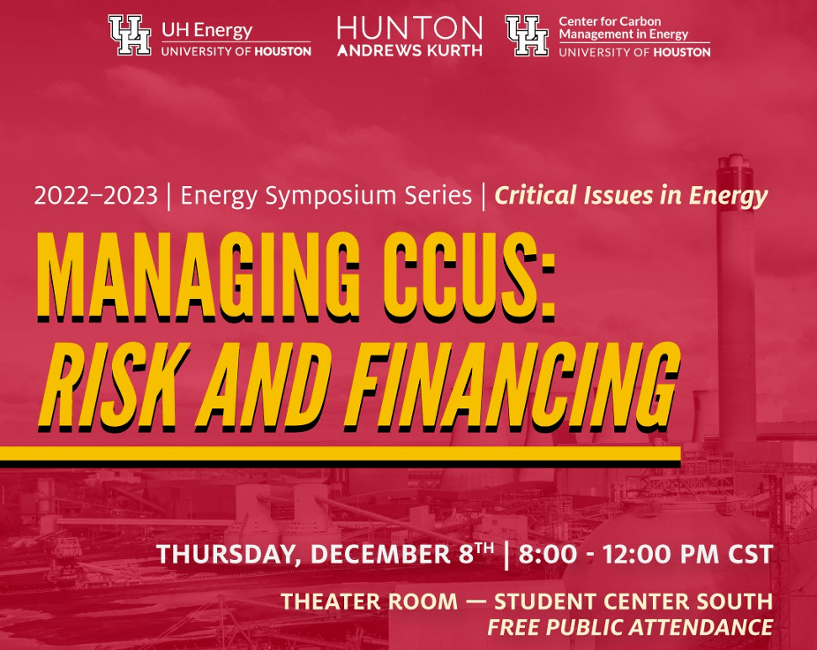Experts Examine CCUS Risk Management During Energy Symposium By Angela Jardina

Carbon capture, utilization and storage (CCUS) is a necessary aspect of the energy transition. However, investment may stall thanks to uncertainty surrounding an understanding of potential liabilities and risk, management issues, and the intricacies of financing.
With this in mind, the Center for Carbon Management in Energy (CCME) started the conversation on navigating these aspects and more as students, faculty and industry professionals gathered on Dec. 8 for the latest installment of the UH Division of Energy and Innovation’s Critical Issues in Energy Symposium Series, titled “Managing CCUS: Risks and Financing.”
Hunton Andrews Kurth co-sponsored the event, which featured a slate of speakers representing various pieces of the CCUS puzzle: legal, financial and research.
The event included professionals from the legal and scientific fields as they worked on deploying CCUS. Sallie Greenberg, principal research scientist of energy and minerals at the University of Illinois, shared information about the risk and process of geologic carbon storage. Greenberg tracks the development and success of this process by tracking the way the language pertaining to its evolution has changed.
“We started out talking about technical and non-technical barriers to carbon storage in 2011 we talked about challenges still but with pathways through, in 2015 we talked about their successes, and since 2017 we’ve been talking about commercial deployment,” Greenberg stated. “There is a significant amount of CCUS activity happening in the US, partially because of the tax breaks associated with it, but also because of the United States’ leading participation in this research.”
In addition to laying out the process of vacuuming carbon out of the atmosphere and subsequently repurpose it, Greenberg sought to alleviate the fear of perceived risks of carbon storage, citing underground seismic surveys as one method of mitigation.
“It’s a complicated matrix of all the things that go into being able to do what it takes for carbon storage,” she said. “Science and engineering move at a different timeline than policy. It took us 25 years to get to where we are right now in terms of geology and engineering. We had to do that work to get where we are right now so that policy can carry us forward.”
Industrial Economics Principal Chiara Trabucchi introduced a deeper outlining of risks regarding CCUS, but with a specification on finance. Trabucchi is engaged in the design of large-scale risk management framework for the protection of the public trust.
Trabucchi attributes the low success of the deployment of CCUS to the misalignment of terms that describe what is at risk, and whether the consequences of risks are material from a financial aspect. She states that excessive focus on the uncertainty of what might go wrong puts unrealistic expectations on the financial realm.
“These concerns are arbitrage. The more uncertain you are, the less interested they are in putting their capital behind your money,” Trabucchi said.
Jim Walsh, senior vice president with global insurance brokerage giant Marsh, said that the main concern of clients who want to invest in CCUS is whether or not insurance can trade off the risk of CCUS to the marketplace, to which he answered “broadly, yes.” Walsh echoed the theme of the day’s discussion, which is that the biggest concern of deploying CCUS is whether the risk can be covered and financed.
Hunton Andrews Kurth Partner Lorie Masters discussed options outside of traditional insurance markets that may take risks off an investor's balance sheet. She presents captive insurance, which differs from regular insurance by being a form of insurance wholly owned by the entity. The advantage of taking this route is that corporations would be able to structure the insurance to respond how they want it to respond.
“It can respond to unique or developing risks,” Masters said. Irfan K. Ali, the founder of DigiKerma, discussed his blockchain-based initiative to help speed up the deployment of CCUS. Ali is motivated by the fact that in developing countries, the government is not always able to provide the same incentives.
“The idea behind this is how can we get the government out of the way, rather than rely on them all the time to come up with tax credits like 45Q, etc.,” Ali said. “What we are attempting to do is bypass the agencies, the regulations, and just bring credits available to anyone who wants to participate and tie them back to CCUS.”
Touting the growth and expansion of the CCME and CCUS consortia, CCME Energy Center Officer Charles McConnell explained the fork in the road regarding which route to take in terms of financially buoying CCUS and deciphering the regulatory framework that guides progress in the marketplace.
“Everybody in the industry right now knows the opportunities that abound, the situation that we have here in the Gulf Coast, which is unique and special. I could go on and on, but we know it already,” McConnell said. “But what we also know are the things we don’t know or want to find solutions for, and that’s why we’re here. Financing means a lot more than just 45Q.”